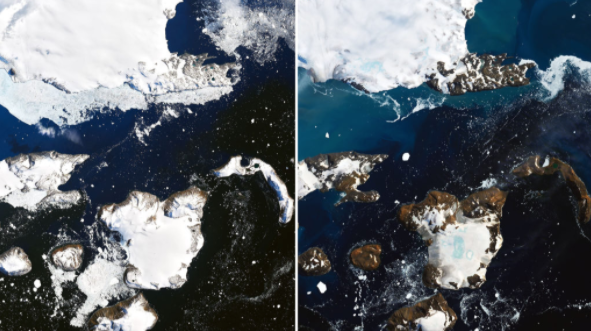Another record broken in Antarctica. Certainly not one to be proud of. Satellite images released by Nasa have made headlines, revealing the extent of glacial melt over the last few weeks in the southernmost continent. Temperatures reached up to 20.75 degrees Celsius, with scientists indicating that these heatwaves are not only getting more intense but are also lasting longer. However, as these records are getting all the headlines, what is most worrying is the general warming trend.
Satellite images of Eagle Island reveal that what just a few weeks ago was ice and snow is now a blotch of exposed land and melt-water ponds. A visual representation of the record-breaking temperatures that have swept across the Antarctic, reaching a peak of 20.75 degrees Celsius on Seymour Island on February 9. Almost a full degree higher than the previous record established on Signy Island in 1982.
Satellite images show the effects of a prolonged warm spell on Eagle Island, which led to around 20% of seasonal snow accumulation melting in just 10 days. The blue areas surrounded by snow in the picture below are ponds of melted water.

Taken just 9 days apart, the before and after images released by NASA show the extent to which high temperatures have impacted the region. “The warm spell caused widespread melting on nearby glaciers,” the space agency says. “Such persistent warmth was not typical in Antarctica until the 21st century, but it has become more common in recent years.”
NASA reports that the Antarctic is one of the fastest heating regions on Earth, with average temperatures in the last century having risen almost 3 degrees Celsius. Weather stations near the northern tip of the peninsula, and on neighboring islands, logged high temperatures giving further confirmation that the continent is warming and warming fast.
More intense and longer-lasting extreme weather events
Alexandra Isern, head of Antarctic sciences at the National Science Foundation, discusses the recent heatwave. She highlights how it has lasted for over a week, leaving many researchers with the impression that these events are not only more intense but they “are lasting longer than they did [in the past].”
However, Isern was also quick to point out that what is occurring in the last few weeks cannot, strictly speaking, be considered a climate event. Rather, it is a weather event that has occurred due to a combination of factors: “Typically, the peninsula is shielded from warm air masses by the Southern Hemisphere westerlies, a band of strong winds that circle the continent. However, the westerlies were in a weakened state, which allowed the extra-tropical warm air to cross the Southern Ocean and reach the ice sheet. Sea surface temperatures in the area were also higher than average by about 2-3°C”, explains NASA.

Although this is a weather event, scientists will now set out on the endeavor of understanding if it is related to a broader climate phenomenon. In fact, the latest February heatwave is the third in a particularly hot 2019-2020 summer, with warm spells in November 2019 and January 2020. “If you think about this one event in February, it isn’t that significant,” explains Mauri Pelto, a glaciologist at Nichols College. “It’s more significant that these events are coming more frequently.“
Climate crisis in the Antarctic
According to Peter Neff, an Antarctic glaciologist at the University of Washington, “I think it’s not at all surprising. It’s part of the trend, and we’re going to see more of those warm events than cold events [in the future].”
Although stand-alone record temperatures steal the headlines, what scientists are increasingly worried about is the general trend. In fact, there is a scientific consensus that Antarctica has some of the fastest-warming air and sea temperatures on the planet.
Furthermore, the combination of high air and sea temperatures has caused massive ice loss. Between 1992 and 2017, the rate of ice loss from the Antarctic Peninsula nearly quintupled, from 7 to 33 billion tons a year.
Although weather stations in Antarctica are a relatively new phenomenon, and hence data does not go as far back as in other regions of the world, scientists are able to get a clear picture of past temperatures by drilling ice cores. This technique involves removing cylinders of ice from ice sheets and glaciers which contain yearly snapshots of the atmosphere going back centuries or even millennia.
Ice core readings in Antarctica reveal that the recent levels of summer heating are unprecedented in the last 1000 years and that these could lead to extensive ice shelf decay.
Another way of measuring long term trends is by looking at land ice elevation. NASA has been collecting more and more land ice elevation data in Antarctica, and scientists are now able to track and measure changes to ice levels over time. The data visualization video below, recently released by NASA, shows the last 25 years of Antarctic land ice elevation change, giving yet another irrefutable demonstration of the substantial loss in land ice that has occurred in less than half a century. Areas highlighted in red indicate land ice loss. Areas in blue are regions that saw land ice elevation gains.

